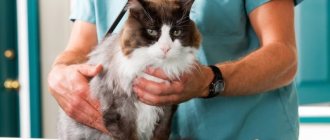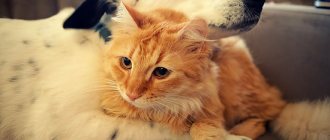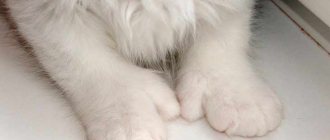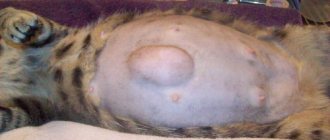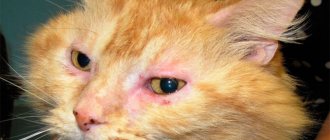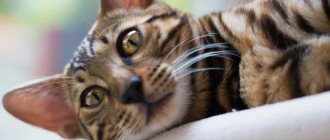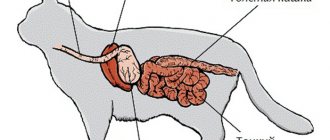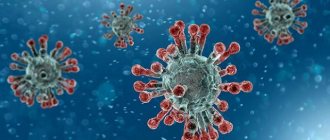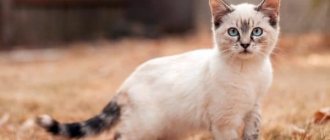Spaying or ovariohysterectomy is performed to remove the ovaries and uterus. This surgical intervention is considered the most popular in veterinary practice. Its prevalence is due to the fact that the operation allows pet owners to be relieved of their irritable behavior during estrus, as well as to solve the problem of unplanned offspring.
Dog ovariohysterectomy - what is it?
Removing a dog's uterus and ovaries is called ovariohysterectomy or castration. This operation will save the pet from heat and make her more oriented toward her owners. The dog's mood will be more even, it will become trainable and calm.
Some owners think that after an ovariohysterectomy an animal will become lazy, lose interest in life and feel inferior. This is not true; the dog will forget about the operation within a few days. Animals do not have a feeling of irreparable loss after castration; they do not worry at all about the fact that they will subsequently not be able to have offspring.
Ovariohysterectomy is the choice of a caring owner. Even a single birth wears out a dog’s body, and it subsequently requires a long recovery period. If a dog gets pregnant every time she goes into heat, it causes irreparable harm to her.
Cat ovariohysterectomy:
· relieves the pet from physical suffering;
· normalizes character, makes the animal more affectionate and calm;
· prevents the cat from reproducing;
· extinguishes sexual instincts;
eliminates the risk of inflammatory processes and tumor processes in the uterus, ovaries, mammary gland (with early sterilization)
Sterilization of pets is also carried out when a pathological process or hormonal imbalance is detected. Cat ovariohysterectomy: the surgical technique is selected taking into account the age of the animal, the location of the reproductive organs, and the pet’s health condition. The following surgical techniques are available:
- standard method - sterilization of the cat with extirpation of the uterus along the white line of the abdomen;
— laparoscopic method;
— sterilization of cats via lateral access with hysterectomy.
Ovariohysterectomy of a cat: the price for this operation ranges from 3 to 5 thousand rubles. You will be able to find out the exact cost only after a conversation with the doctor, examination of the animal and the final choice of tactics for the operation.
| Services | Unit change | Prices |
| Sterilization of cats | 1 procedure | from 2500 |
| Extirpation of the cat's uterus (without the cost of drugs) | 1 procedure | from 3000 |
| Medical termination of pregnancy (without the cost of the drug) | 1 procedure | 300 |
| Caesarean section for a cat | 1 procedure | from 4500 |
| Premedication | 1 procedure | 500 |
| General non-inhalation anesthesia (cost is determined depending on the weight of the animal and the duration of the procedure) | 1 procedure | from 500 |
| Calling a veterinarian to your home | call | from 500 |
At what age is it better to have surgery?
There is a well-established opinion that an ovariohysterectomy in a dog should be performed after several heats or after giving birth. It is believed that the operation can affect the development of a young animal and even slow it down. Some people far from veterinary medicine claim that ovariohysterectomy can change the genetics of an animal. These are all myths.
Doctors recommend surgery on dogs between 6 and 12 months of age, at the very beginning of puberty. Early ovariohysterectomy further reduces the risk of developing breast cancer in animals and eliminates the likelihood of purulent inflammation of the uterus.
After sterilization, the animal does not stop developing. It is not the surgery that influences the future weight and size of the dog, but a balanced diet, genetic predisposition and quality care.
When should an intervention not be carried out?
It is allowed to carry out the procedure on individuals who are more than six months old.
There are no absolute contraindications to ovariohysterectomy, since studies show that even early sterilization does not cause pathologies or developmental disruptions. Despite this, in young cats less than six months old, the anesthetic risk increases. It is recommended to perform ovariohysterectomy on pets over 6 months of age.
Indications for sterilization
The main indication for castration of a dog is the desire of its owners. If they are tired of estrus and crowds of male dogs near the house, then the pet needs an ovariohysterectomy. Once the uterus and ovaries are removed, the dog will no longer have sexual cycles.
For medical reasons, ovariohysterectomy is almost always performed for purulent inflammation of the uterus - pyometra. In this case, conservative treatment is also possible, but it is rarely effective. Ovariohysterectomy allows you to save your dog's life and health.
Castration is also recommended for false pregnancy, especially if it occurs repeatedly. Irregular cycles or prolonged heavy bleeding during estrus indicate a problem. In this case, it is also advisable to have the dog undergo surgery to remove the uterus and ovaries.
Castration is also indicated for pathological difficult births. Ovariohysterectomy is also performed for ovarian tumors, hormone-dependent alopecia, and breast cancer.
First, some terminology:
Let’s break down the complex word “ovariohysterectomy” into its component parts. -ovario (ovaria) - ovaries -hystero (hystero) - uterus -ectomy (ektome) - excision * * the term “ectomia”, which means cutting or removal, should not be confused with the term “ectopia”, which means a congenital pathology of abnormal location of an organ or fabric. Ectopia has nothing to do with issues of castration and sterilization. It turns out that ovariohysterectomy is the removal of the uterus and ovaries. Actually, this is the most common method of castration of female domestic and wild animals. Castration can also be called oophorectomy - that is, removal of only the ovaries. This method is suitable for young and never given birth dogs and cats. But we still recommend ovariohysterectomy - complete removal of both the uterus and ovaries. An operation to remove the uterus and ovaries is in no way more difficult or difficult than an operation to remove only the ovaries. But in terms of reliability - complete removal - it is much higher. After complete removal of the uterus and ovaries, there is no fear that the uterus, left without hormonal support, will ever become inflamed or undergo tumor growth.
Girls (females), as well as boys (males), are castrated. Castration means complete removal of the gonads. Therefore, it would be more correct to say “castration of a cat” or “castration of a dog.” In everyday vocabulary, in order to avoid confusion, when talking about female animals, we say “sterilization,” and when talking about male animals, we say “castration.” Although, if scientifically correct, then all this is castration in both sexes. Sterilization, if again scientifically correct, is the deprivation of reproductive function without removing the gonads. In females this is a tubal ligation. In males - ligation of the vas deferens. Bandaging operations are performed rarely and for necessary medical reasons. Indeed, as a result of dressing, animals of both sexes, although they lose the ability to reproduce, their hormonal status is completely preserved: females continue to estrus, and males retain all their desires. A “bandaged” bitch and male or male and female cat do not lose the ability to mate, fight, have an unbearable temperament, to “mark the territory”, and most importantly, they are also susceptible to diseases of the reproductive sphere.
In general, the most correct and safe sterilization of cats and dogs is removal of the uterus and ovaries (ovariohysterectomy). With modern methods such as laparoscopy and microlaparotomy, the operation is easily tolerated. The entire surgical procedure is performed through a small puncture approximately in the center of the abdomen. And already on the day of the operation, you are allowed to lead a normal, habitual lifestyle: walk, eat and drink. And, importantly, after laparoscopic or minimally invasive sterilization of bitches and cats, no care is required. No treatment, care, medications or suture removal are required.
Appearance of a hairless Sphynx cat after ovariohysterectomy using a minimally invasive method. A bump of no more than 1 cm from the internal suture remains on the skin. The patient’s weight is 2.5 kg.
Appearance of an Alabai mixed breed dog after ovariohysterectomy using a minimally invasive method. On the skin there is a mark from the internal seam no more than 1 cm. The patient’s weight is 60 kg.
FAQ
Question #1: I can’t decide whether to spay my Yorkie girl. It seems like I want puppies, but I'm afraid that there will be a lot of problems with them. Is it possible to carry out such an operation if the dog has already given birth?
Answer: Of course you can. If there are no contraindications, then you need to choose when to sterilize. It can also be done after the bitch has had puppies. But not earlier than a month or a month and a half after giving birth, only after the mother has fed all the puppies and her milk has disappeared.
Question No. 2: We have such a problem. A 2.5 year old Yorkie girl. She suffered two false pregnancies, and we decided to sterilize her. How dangerous is this?
Answer: The fact of previous false pregnancies is not a contraindication for sterilization. Moreover, “false veins” can indicate hormonal dysfunction and can lead to serious diseases of the uterus and mammary glands. If you do not plan to have offspring, sterilize without hesitation.
Question No. 3: I am not going to exhibit my Japanese Chin puppy at shows and breed with someone. He is now five months old. Is it possible to do castration now, how risky is it and how can the character of the animal change?
Answer: According to experienced doctors who sterilize Yorkies and small breeds of dogs, such operations are best done at the age of 6 months to a year. There is no particular danger if there is no honey. There are no contraindications and the operation is performed by an experienced surgeon. The character usually becomes calmer, but there are exceptions.
Question No. 4: We have a large Alabai male. We also want to get ourselves a female Yorkie. We don't need matings. If you sterilize a girl, will she stop going into heat? And when can she be sterilized?
Answer: Of course, estrus will stop and this will not affect the quality of life in any way. The operation removes the uterus and ovaries. It is important that the Alabai is friendly towards the new pet. Your Yorkie will need to be sterilized in about six months.
Question No. 5: We adopted a Yorkie girl, whom we do not plan to breed with anyone in the future. Doctors say that you can do an oophorectomy or ovariohysterectomy. What is it, how are they different and why are they dangerous?
Answer : Ovariectomy - removal of only the ovaries, ovariohysterectomy - removal of the uterus along with the ovaries. In the first case, some inflammatory processes in the uterus are possible. In the second they are excluded. In general, sterilization of a Yorkie does not threaten the life of the animal in any way and is usually easily tolerated by it. In general, consult a good veterinarian, let him examine the animal and determine whether it can be sterilized and which operation option is best to choose.
Question #6: Our Yorkie boy is already seven months old, but his testicles have not yet descended into his scrotum. We went to the doctor, he prescribed hormonal medications by injection. Nothing has changed, and probably won’t change. Doctors advise castration, otherwise testicular cancer may develop. Is it so?
Answer: At the seventh month, normally the testicles should already be located in their normal place - in the scrotum. Most likely, nothing will really change and castration is indicated for you according to medical advice. reasons. Indeed, there is a fairly high risk of “failed” testicles degenerating into a malignant tumor.
Owner reviews about the operation (from the site veterinar.ru)
Tatyana: We suffered a lot when our dog went into heat every four months. It was simply impossible to walk with her for two whole weeks. A whole army of assorted males gathered behind the girl and behaved very aggressively. We were very afraid at this time both for ourselves and for our Matilda. When we got tired of this situation, we decided to talk to the veterinarians. They advised me to undergo sterilization. We found a very good veterinary clinic, where we had the operation. Everything went quickly and easily, and now we have no problems with heat.
Andrey Vladimirovich: My family has long wanted a Yorkie boy, and finally we got one. The owners of the same dogs advised us to sterilize him as early as possible if we do not want to breed a boy. They waited until he was 11 months old and castrated him. Everything went just great! Now we have a calm, balanced dog in our house, playful and healthy.
Sergey: My wife bought a Yorkshire terrier a couple of years ago, not intending to have offspring from him. Just for myself. Therefore, we were immediately inclined towards sterilization, but we were afraid that the dog would start to get sick or become aggressive. Nothing like this! Neutered Yorkshire terriers become sweethearts! After the operation, our Babush turned into an affectionate, playful and very sweet creature.
Doctor of Veterinary Medicine M. Shelyakov
How to Prepare Your Dog for an Ovariohysterectomy
There are no vaccinations before ovariohysterectomy; take care of vaccinations in advance. It is not recommended to deworm or treat for fleas before castration. Check with your doctor ahead of time for details, such as whether they provide a blanket for your dog after surgery. If not, then you will have to purchase it yourself or sew it.
12 hours before ovariohysterectomy, the animal stops feeding. The operation on dogs is performed on an empty stomach, this is done to avoid vomiting and to reduce the consumption of anesthesia. Before visiting the clinic, give your pet a good walk and make sure she has emptied her bladder.
Pre-prepare at home the place where the dog will be after the operation. After recovering from anesthesia, the animal is poorly oriented in space, so you should not place it on a hill. Place a large hygienic diaper under the dog; it can be purchased at a pet store.
Technique of the operation
Below we will take a closer look at the technique of performing ovariohysterectomy of a cat using a lateral incision.
- The area of the animal's skin is shaved widely and washed thoroughly.
- Release the bladder by pressing with your hand on the abdominal wall.
- The cat is transferred to the operating table, fixed in a lateral position, and the pelvic limbs are pulled back.
- The doctor prepares the surgical field.
- He then vertically incises the skin 2–4 cm.
- The subcutaneous fat is completely incised or partially excised, exposing the external oblique muscle of the abdomen.
- The internal oblique abdominal muscles, external and transverse abdominal muscles are divided in layers along the fibers.
- The abdominal cavity is opened in a blunt manner using atraumatic forceps.
- Carefully sorting through the intraperitoneal tissues, they find the broad ligament or the nearest uterine horn (some surgeons use a hook for this).
- By carefully pulling the animal's uterine horn, the ovary and suspensory ligament are removed.
- The ovarian vessels are ligated. As a rule, one ligature is applied.
- The broad ligament on both sides is carefully separated, with little chance of bleeding.
- The uterus is cut off as close to the cervix as possible.
- The muscles are sutured together or in layers.
- The skin and subcutaneous fascia are closed in the usual manner.
The advantages of this technique are to minimize tissue trauma and postoperative pain in the cat. Antibiotic therapy is not required in this case
After the operation, the animal does not need post-operative care, so cats that are used to walking outside are allowed to be released into their usual habitat a few hours after the operation.
Video of the operation:
How is the operation performed?
Ovariohysterectomy in dogs is performed under general anesthesia. The animal is given an injection, after which it falls asleep. The veterinary surgeon fixes the dog on the table, treats the surface with alcohol and makes a small incision. The doctor finds the uterus and ovaries in the dog's abdomen and then removes them. The veterinarian applies a triple suture to the wound.
The edges are treated with iodine or another antiseptic. A sterile napkin is applied to the seam. Afterwards, a blanket is put on for the dog after surgery.
In some clinics, the furry patient is observed until he fully recovers from anesthesia, while in others, immediately after surgery, he is given to the owner. The doctor may invite the owner to come to the clinic the next day to examine the animal. Sometimes a course of antibiotics is prescribed after surgery.
Cat sterilization surgery: from A to Z
Preoperative preparation
What is the preoperative preparation?
During surgery, it is desirable that the animal's stomach and intestines are empty. Therefore, we recommend giving your cat a tablespoon of Vaseline oil as a laxative 24 hours before surgery.
Before the operation, it is necessary to undergo a 12-14-hour fasting diet, and remove water 1 hour before the operation.
We also recommend purchasing 2 post-operative blankets in advance. We recommend hemming the edge of each ribbon of the blanket so that after the operation, when licking, the cat does not pull the thread out of the ribbon and swallow it.
You can try on a blanket for your cat before surgery. This way, owners learn to put on a blanket and can see how the animal reacts to it. Usually cats do not like blankets and behave awkwardly in them.
Progress of the operation
Ovariohysterectomy is performed under general anesthesia, anesthesia is administered intramuscularly, intravenously or inhalation. Not all owners know that the eyes of cats under anesthesia are open, so during the operation we apply a special gel to the cornea so that it does not dry out.
The owner does not need to know every step of a cat's ovariohysterectomy, but it is necessary to know the main points.
We prefer to perform a surgical approach for ovariohysterectomy along the midline (white) line of the abdomen. This technique makes it possible in all cases to completely remove uterine tissue, which eliminates the risk of further occurrence of pyometra of the uterine stump. An important stage of the operation is the removal of the ovaries. All ovarian tissue must be completely removed during surgery to prevent the cat from going into heat. The uterus must be excised completely below the bifurcation (division into two horns).
Caring for your dog during the postoperative period
After an ovariohysterectomy, bring your dog home and place it in a pre-prepared area. It is important to remain quiet and not to irritate the animal. Soon the dog will begin to recover from the anesthesia and try to get up; it is important to control it at this moment. Try to protect it from falling on hard objects.
You cannot force water on your dog; wait until he has completely recovered from the anesthesia. If the animal has already regained consciousness, then you can offer it warm water. Monitor the drinking process, as the dog is still weak.
On the day of surgery, do not give your pet food. The next day you can offer her canned food. The digestive system in the postoperative period is very vulnerable; overloading it with heavy food is unacceptable. After defecation, the dog can be returned to its usual diet.
How to make a choice
Ovariectomy is justified when:
- The cat has never given birth before.
- Age 7-9 months, until the first or second heat.
- The uterus has no pathologies.
- There is no way to provide long-term care after surgery, while laparoscopy (through a puncture) cannot be done for some reason.
Surgery to remove the ovaries through lateral incisions is a good alternative to the endoscopic method in some cases. This is the method used to sterilize stray animals when they are planned to be released immediately. The stitches from such an operation take longer to heal and hurt more, but the risk of bleeding is lower, and it is more difficult to lick or comb the stitches. This is a crucial moment when the cat is free to roam and there is no way to lock it up somewhere under supervision for several days. In addition, older owners may find it difficult to monitor their pet and quickly take action in the event of complications.
Removing the uterus through a side incision is possible, but quite risky . A stump may remain, inflammation may begin, and it will be more difficult to suture. Usually only the ovaries are removed in this way.
Ovariohysterectomy is performed when:
- The cat has already given birth.
- Uterus with pathology.
- The cat is old.
- There were more than 2 unrealized heats.
- A conventional operation is performed along the white line.
With classic laparotomy, it makes sense to remove the uterus immediately . The incision has already been made, the surgeon has a good view. If the uterus remaining in the body becomes inflamed later, or other problems arise (neoplasms, continued estrus, restored ovary), the animal will have to go through this operation again.
Estrus that does not result in pregnancy increases the risk of uterine pathologies. Taking contraceptives further worsens the situation: there are no safe contraceptives for cats. The longer a fertile animal has not given birth, the more indications there are for complete castration.
Many cat owners would like to undergo endoscopic sterilization as it is less traumatic. But due to the high cost, the matter is postponed until later. Moreover, every pregnancy, every unsuccessful sexual heat is costly for the cat. Do not be afraid of the classic operation, it is not without its advantages.
The lower cost makes the procedure accessible and widespread ; doctors gain more experience in laparotomy in any clinic. When operating along the white line, the suture will hurt less. Subcutaneous sutures that do not need to be removed are also applied here. The cat will not be able to run and jump for several days; it will move in small steps; wearing a blanket and collar is necessary, because seam in an accessible place. Supervision will be required for about a week. For young cats that cannot be monitored postoperatively, minimally invasive oophorectomy may be considered.
Possible complications
As with any abdominal surgery, complications are possible after an ovariohysterectomy. If castration is performed by an experienced veterinary surgeon, then the risk of unwanted consequences is minimal.
In some cases, animals may develop involuntary urination. This problem occurs more often in large or giant breed dogs. Usually, involuntary leakage of urine can be controlled with medication; this does not cause problems for owners.
Some owners associate their dog's obesity with ovariohysterectomy. Veterinarians have not found a connection between castration and excess weight in animals with proper care. Providing your dog with proper exercise and a balanced diet will help keep him healthy.
General provisions
You should not ignore the veterinarian’s recommendation to perform an oophorectomy; sterilizing a cat is a natural and necessary operation. The owner needs to know and follow several rules:
- the operation is performed only on a healthy animal;
- do not feed for 10-12 hours before the intervention;
- During the postoperative period, monitor the pet and do not allow it to lick the wound.
Why does a cat get fat after an ovariectomy? It's all about estrogens, which are normally responsible for reducing appetite. The absence of ovaries increases appetite, and laziness and calmness increases the deposition of fat cells. Here it’s up to the owner to give the cat enough physical activity (play) and switch it to low-calorie food.
At the Ros-Vet VC, oophorectomy is performed using modern equipment with minimal risks and rapid postoperative rehabilitation. If you wish, you can call a surgeon at home. Do not ignore the recommendations of veterinarians, call +7 (495) 256-11-11 and come to the Ros-Vet EC.
